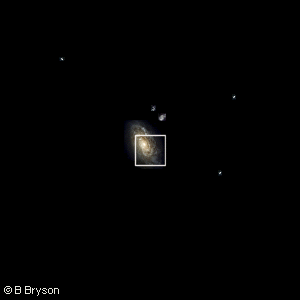Scale: 1022 meters = 10 Zm = 10 zettameters
The Local GroupThis flattened elliptical disk is our own Milky Way, a typical spiral galaxy. It travels in space with several satellite galaxies -- the irregular galaxies nearby are the Small and Large Magellanic Clouds of the southern skies of Earth. The Milky Way is a spiral galaxy of average size, containing roughly 1011 stars. The nearest major galaxy is the Andromeda spiral, just off the image to the lower left. Andromeda is approximately 2 million light years away -- about 20 times the diameter of our galaxy, and is thought to be somewhat larger than the Milky Way. The size of individual galaxies with respect to the distance between them makes galaxies relatively much closer together than are the stars within them. It is therefore common for galaxies to collide without the stars within them colliding. One of the observed effects of galactic collisions is to increase the production of new stars within both galaxies due to the interaction of huge clouds of interstellar gas and dust. Slowly moving and rotating galaxies collide over periods of millions of years. Copyright © 2016 by Bruce Bryson |
